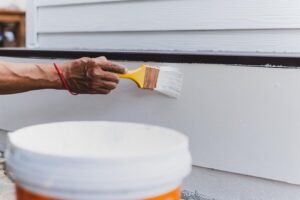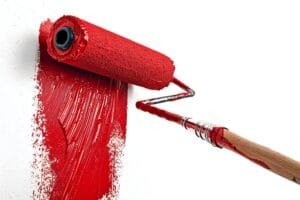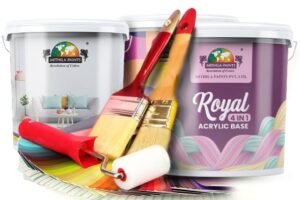Introduction to Primers and Sealers
Primers and sealers play crucial roles in the realm of painting, serving as foundational elements that significantly influence the outcome of any painting project. While both products are essential for preparing surfaces, their purposes and applications differ, making it critical for homeowners and professionals alike to understand their unique functions. Primers are specially formulated coatings applied to surfaces before the application of paint. Their primary purpose is to create a seamless bond between the substrate and the topcoat. This is particularly important when dealing with porous surfaces, as primers help to fill in any imperfections and improve paint adhesion, thus ensuring a more durable finish.
On the other hand, sealers act as protective barriers that prevent moisture and contaminants from penetrating the surface. They are often used on materials like wood and masonry, which are prone to damage from environmental factors. By using sealers, homeowners can extend the life of their surfaces and maintain the integrity of the paint job. In many cases, sealers can also enhance the color and depth of the finish, contributing to a more aesthetically pleasing result. The application of both primers and sealers is especially important when working with specific types of paint, such as mithila paints, which require appropriate preparation for optimal results.
In addition to improving adhesion and protection, primers and sealers can also help to reduce the number of paint coats required, thereby saving time and resources. This efficiency is essential for both large-scale projects and smaller jobs, allowing for a more professional finish with fewer complications. By understanding the significance of primers and sealers, painters can ensure that their work is not only visually appealing but also durable and long-lasting.
What is a Primer?
A primer is a preparatory coating applied to a surface before painting, serving multiple essential functions. The primary purpose of a primer is to create a uniform surface that enhances the adhesion of paint. This important task ensures that the subsequent layers, whether they are mithila paints or other types, adhere properly and provide a lasting finish. Without a suitable primer, paint can peel, flake, or wear out prematurely.
Primers also play a vital role in blocking stains and preventing them from seeping through the topcoat. For example, when painting over surfaces that have previously been stained by water, smoke, or other contaminants, using a primer formulated for stain blocking can help seal those marks and preserve the integrity and appearance of the top layer. This is particularly beneficial when working with delicate designs often found in mithila paints which require a pristine and clear backdrop.
Different types of primers exist, each tailored for specific surfaces and conditions. For instance, oil-based primers are excellent for wood, as they penetrate and seal the surface effectively, while latex-based primers are often recommended for drywall and masonry due to their quick drying time and ease of cleanup. There are also specialized primers for metal surfaces, which can prevent rust and corrosion, ensuring durability. Understanding the characteristics of the surfaces you are working with and choosing the appropriate primer is crucial for achieving optimal results in your painting project.
In summary, the use of a primer is indispensable in any painting endeavor, not only for adhesion but also for enhancing the longevity and quality of the finish, making it an essential step in the painting process.

What is a Sealer?
A sealer is a vital component in the realm of surface coatings, particularly in painting projects. It serves as a protective layer applied over surfaces, thereby extending the longevity of the paint and ensuring that the underlying material remains safeguarded from environmental elements. This is especially crucial for surfaces that are frequently exposed to moisture, sunlight, and temperature fluctuations, as these factors can deteriorate the painted finish. Sealers act as a barrier, preventing the penetration of water and other damaging agents, thus enhancing the durability of Mithila paints applied over them.
One of the fundamental roles of sealers is to provide moisture resistance. By forming an impermeable layer, they ensure that any moisture present does not compromise the structural integrity of the substrate beneath. This is particularly essential in areas such as kitchens, bathrooms, or exterior walls, where high humidity levels are prevalent. Furthermore, sealers can also help in maintaining the vibrancy of the color by providing a stable surface that minimizes fading. This is significant for projects that utilize Mithila paints, as these vibrant, traditional designs can lose their luster over time if not adequately protected.
There are primarily two types of sealers: clear and tinted. Clear sealers are transparent, allowing the original color of the painted surface to shine through while offering protection against UV rays and moisture. On the other hand, tinted sealers come with added pigments, which can enhance the hue of the existing paint, contributing to a richer and deeper appearance. The choice between these two types often depends on the desired aesthetic outcome and the specific requirements of the project. Understanding these differences is essential for anyone looking to utilize sealers effectively in conjunction with Mithila paints.

Difference Between Primers and Sealers
In the realm of painting and finishing, it is crucial to distinguish between primers and sealers, as both serve distinct yet often misunderstood roles in the preparation and finishing process. While they may appear similar, their applications and functions diverge significantly. Primers are designed primarily to enhance the adhesion of paint to the surface. They create a uniform base that helps in improving the durability and longevity of the topcoat, especially on surfaces that are porous or uneven. Additionally, they play a vital role in blocking stains or underlying colors, ensuring that the final paint application maintains its true hue and finishes smoothly.
Conversely, sealers do not function as a base for paint; instead, they are employed to protect surfaces from moisture and other environmental factors. Sealers are particularly useful for porous materials, such as wood and masonry, as they prevent water infiltration and subsequent damage. Unlike primers, which can alter the surface texture, sealers tend to enhance the existing finish, providing a transparent protective layer that can be either matte or glossy. This distinction leads to the common misconception that primers and sealers are interchangeable, which is not the case.
When planning a painting project, it is essential to evaluate the specific requirements of the surface in question. If the objective is to improve paint adhesion and coverage, selecting a quality primer is warranted. On the other hand, if the focus is on protection against the elements, particularly for outdoor applications or surfaces exposed to moisture, a sealer is the appropriate choice. Understanding the fundamental differences between primers and sealers can significantly influence the outcome of your painting project, ensuring that the right products are used for optimal results.
When to Use Primers and Sealers
Primers and sealers play a crucial role in achieving a successful painting project, particularly when dealing with different surfaces and conditions. It is essential to understand when to incorporate these essential paints into your workflow to ensure optimal adhesion, durability, and overall appearance of the finish.
For new drywall, applying a quality primer is highly recommended before painting. Given that fresh drywall is porous, a primer helps to seal the surface and provides a uniform base for the paint, preventing it from soaking into the drywall unevenly. This means that fewer coats of paint are required, leading to potential cost savings and a smoother finish. Products specifically designed for drywall offer superior results, so opting for popular primers from reliable brands is wise.
When working with wood surfaces, such as trim, molding, or cabinets, primers are equally important. Paint adheres better when a primer is applied, especially if the wood is bare or has not been painted for some time. In such cases, a high-quality wood primer fills in imperfections and prevents tannin bleed, a phenomenon where natural resins in the wood can discolor paint. Select primers tailored for exterior or interior wood surfaces depending on your project requirements.
For previously painted areas, the necessity of using a primer depends on the condition of the existing paint. If the old paint is peeling, chipping, or has a glossy finish, it is advisable to use a primer to ensure an even and durable topcoat. Using a bonding primer can significantly improve the adhesion of the new paint to the old surface, preventing future issues.
In conclusion, understanding when to use primers and sealers is essential for any painting project. By selecting suitable products for new drywall, wood surfaces, and previously painted areas, one can achieve a polished appearance and prolong the longevity of the finish. This knowledge allows for the effective use of Mithila paints and other high-quality alternatives, resulting in a successful application.


Application Techniques for Primers and Sealers
Applying primers and sealers effectively is crucial for achieving a long-lasting and durable paint finish. A few best practices stand out when it comes to utilizing these essential paints. First and foremost, the selection of tools plays a significant role in the application process. Brushes, rollers, and spray guns are commonly used for applying primers and sealers, and each has its advantages depending on the surface area and texture. For example, rollers are ideal for large, flat surfaces, while brushes can reach intricate details and edges effectively.
Before applying any primer or sealer, proper surface preparation is vital. Ensure that the surface is clean, dry, and free from oils, dust, or old paint. For surfaces with peeling or chipping paint, it is essential to scrape and sand down to a smooth finish. If you are working with porous surfaces, like wood or drywall, applying a latex primer will help create a suitable base for the topcoat. For glossy surfaces, such as metal, a light sanding will help the primer adhere better, providing a strong foundation for the subsequent layers of paint.
During the application of Mithila paints, it is important to maintain a consistent thickness while applying primers and sealers. Using a paint edger can help achieve clean edges, while a roller can cover larger sections uniformly. It’s advisable to work in manageable sections to avoid overlaps, which can lead to an uneven finish. Additionally, be mindful of the environment; applying these paints in optimal temperature and humidity conditions can significantly affect their performance.
Challenges may arise during the application process, such as bubbles forming or uneven texture. To address these issues, ensure you are not overloading your brush or roller with product and that you have sufficient drying time between coats. Ensuring the right application techniques will lead to a successful outcome, reinforcing the longevity of the Mithila paints used in your projects.
Common Mistakes to Avoid
When undertaking painting projects, particularly with specific applications such as mithila paints, several common errors can impede the desired outcome. One of the most frequent mistakes is the decision to skip the primer. Primers serve as a preparatory layer that enhances adhesion, increases durability, and ultimately ensures a more vibrant color payoff. Neglecting this essential step may lead to peeling or uneven appearances, especially when working with textured or porous surfaces.
Another prevalent pitfall is incorrect application methods. For instance, applying primers or sealers with inappropriate tools can lead to a myriad of issues, such as streaks or bubbles in the final finish. It is crucial to select the right brushes, rollers, or sprayers designed for the specific product type. For those using mithila paints, select tools that will properly deliver these intricate designs and ensure the desired texture is achieved without compromising the quality.
Furthermore, understanding and adhering to proper drying times is vital. Many individuals either rush the process or do not allow sufficient time for each layer to cure before applying additional coats. This miscalculation can compromise the integrity of the entire paint job, leading to problems such as blistering or uneven texture. Always refer to the manufacturer’s instructions regarding drying times for primers and sealers to guarantee the best results.
To avoid these common mistakes, take the time to plan your project thoroughly. Invest in the right materials and tools, and always adhere to recommended application techniques and drying times. By doing so, one can maximize the efficacy of primers and sealers, ensuring that the final impression remains as stunning and vibrant as envisioned—much like the unique patterns found in mithila paints.
Choosing the Right Primer and Sealer
When embarking on a painting project, selecting the appropriate primer and sealer is crucial to achieving the desired results. The first consideration should be the type of surface that will be painted. Different materials such as wood, metal, drywall, or masonry require specific types of primers that are formulated to adhere well and create a smooth base for the paint. For example, if working with mithila paints, a primer designed to enhance adhesion will ensure that the rich colors are properly showcased while preventing peeling or flaking.
Environmental factors also play a significant role in the selection process. Consider the location where the painting will take place—interior or exterior spaces can greatly affect the performance of a primer and sealer. Exterior sealers, for instance, are formulated to withstand harsh weather conditions and UV exposure, while interior primers may focus on odor control and stain blocking. Selecting a primer that aligns with these conditions not only protects the underlying surface but also extends the lifespan of the painting project.
Another essential aspect to consider is the desired finish. Different finishes, such as matte, satin, or glossy, can influence the choice of both primer and sealer. Some primers are designed to work specifically with high-gloss finishes and can significantly impact the final appearance of mithila paints applied over them. Additionally, the texture and sheen of the primer can reflect how the final coat adheres, contributing to a uniform look. It is important to read product labels carefully and choose primers that align with both the paint type and the final aesthetic intention.
In conclusion, effectively selecting the right primer and sealer involves considering the type of surface, environmental conditions, and desired finishing touches. Doing so not only aids in achieving a professional look but also protects and enhances the lifespan of your project, especially when employing decorative techniques such as Mithila paints.

Conclusion
In the realm of painting, the importance of using primers and sealers cannot be overstated. These essential products serve foundational roles that significantly enhance the quality and longevity of any paint job. Primers create a consistent surface for the topcoat to adhere to, thereby improving coverage and minimizing the chances of peeling or chipping. Whether working with traditional mithila paints or more modern formulations, the use of a primer tailored to specific surface needs ensures that the colors appear vibrant and hold their integrity over time.
Sealants complement this process by providing an added layer of protection. This is particularly advantageous in environments subjected to moisture or extreme temperatures, where the resilience of mithila paints may be compromised. Sealers not only protect against wear and tear but also help in maintaining the beauty of the paint finish, preserving its aesthetic appeal for years to come. The application of these products is often viewed as an extra step; however, it is an investment in the durability and professionalism of the finished project.
For those embarking on their next painting endeavor, it is worthwhile to consider both primers and sealers as indispensable components of the process. Their ability to elevate the performance of mithila paints enables individuals to achieve a high-quality outcome that reflects creativity and expertise. By embracing these essential products, painters can ensure that their work not only meets but exceeds expectations, resulting in a polished appearance that withstands the test of time. Efforts spent in preparation, including the use of effective primers and sealers, will ultimately pay off in the satisfaction derived from a job well done.
